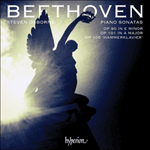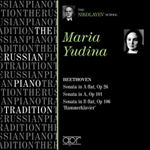
Welcome to Hyperion Records, a British classical label devoted to presenting high-quality recordings of music of all styles and from all periods from the twelfth century to the twenty-first.
Hyperion offers both CDs, and downloads in a number of formats. The site is also available in several languages.
Please use the dropdown buttons to set your preferred options, or use the checkbox to accept the defaults.

The sonata was begun about the middle of 1815, but was set aside for a time before being taken up again the following summer; it was completed in November 1816, as indicated by the date on the autograph score. At this time, as seen in Op 90, Beethoven was attempting to introduce German terms rather than the conventional Italian ones, and so for publication each movement was provided with a German tempo indication (as well as an Italian one, to assist sales outside German-speaking countries). He also wanted a German term to replace the Italian ‘pianoforte’, and after extensive consultation decided on ‘Hammer-Klavier’, although the term has since become associated almost exclusively with his next sonata (Op 106). There was also much discussion about the title for the sonata, and Beethoven suggested facetiously that it should be called ‘The difficult-to-play Sonata in A’. In the end this title was not adopted, but the sonata certainly is difficult to play. It was dedicated to Baroness Dorothea Ertmann, a close friend of Beethoven and an excellent pianist.
The first movement, marked ‘Somewhat lively and with the most intimate feeling’, is deceptively simple and gentle, in a very concise sonata form but with textures that seem to owe something to the preludes of Bach, which Beethoven had learnt as a boy. Instead of the usual minuet or scherzo for the middle movement, there appears a march (‘Rather lively, in march time’) in the remote key of F major. The middle section of this movement forms a smooth and sweet contrast to the march, and during much of it the two hands play exactly the same melody but at slightly different times (a device known as ‘canon’). The music then leads back to the march, which returns unchanged.
The finale, a much longer, more complex movement in several sections, begins as if it is to be a slow movement in A minor (‘Slow and full of longing’), and it contains one of Beethoven’s earliest indications of the soft pedal. After only twenty bars, however, the soft pedal is gradually released as the music gives way to a recall of the first movement (‘Tempo of the first movement’), seeming to suggest a distant memory of events long past. This brief recall increases in energy until it bursts into the finale proper (‘Fast but not too fast, and with determination’). This is in sonata form, but much more expansive than the first movement. Its most outstanding feature is its central fugato (again recalling Bach), which forms almost the entire development section and gradually builds up from a pianissimo bass entry to a mighty fortissimo climax a full hundred bars later. Here Beethoven for the first time ever uses a low E, a note that had only recently been added to the compass of new pianos. To highlight the note, he actually labelled it as ‘Contra E’ in the score. The low E reappears just before the end, this time pianissimo, before being interrupted by the final fortissimo chords.
from notes by Barry Cooper © 2016
Il commença cette sonate vers le milieu de l’année 1815, mais la mit de côté quelque temps avant de la reprendre l’été suivant; il l’acheva en novembre 1816, comme l’indique la date sur la partition autographe. À cette époque, comme on l’a vu dans l’op.90, Beethoven essayait d’introduire des termes allemands en lieu et place des termes italiens conventionnels et, pour la publication, chaque mouvement reçut donc une indication de tempo en allemand (ainsi qu’en italien, pour faciliter les ventes hors des pays germanophones). Il voulait aussi qu’un terme allemand remplace le mot italien «pianoforte» et, après de longues consultations, il opta pour «Hammer-Klavier» mais, depuis lors, ce mot est presque exclusivement associé à sa sonate suivante (op.106). Le titre de cette sonate donna lieu aussi à de nombreuses discussions et Beethoven suggéra facétieusement qu’elle devrait s’intituler «La Sonate en la majeur difficile à jouer». Finalement, ce titre ne fut pas adopté, mais la sonate est certainement difficile à jouer. Elle est dédiée à la baronne Dorothea Ertmann, amie proche de Beethoven et excellente pianiste.
Le premier mouvement, marqué «plutôt animé et avec un sentiment très intime», est moins simple et doux qu’il n’y paraît, dans une forme sonate très concise mais avec des textures qui semblent devoir quelque chose aux préludes de Bach que Beethoven avait étudiés dans son enfance. Au lieu du menuet ou du scherzo habituels pour le mouvement central, apparaît une marche («Plutôt animée, en tempo de marche») dans la tonalité éloignée de fa majeur. La section centrale de ce mouvement forme un doux contraste avec la marche et, la plupart du temps, les deux mains jouent exactement la même mélodie mais à des moments légèrement différents (procédé appelé «canon»). La musique ramène ensuite à la marche, qui revient inchangée.
Le finale, mouvement beaucoup plus long et plus complexe en plusieurs sections, commence comme s’il s’agissait d’un mouvement lent en la mineur («Lent et plein de nostalgie»); il contient l’une des premières indications de pédale douce de Beethoven. Toutefois, après seulement vingt mesures, la pédale douce est peu à peu relâchée lorsque survient un rappel du premier mouvement («Tempo du premier mouvement»), qui semble évoquer le souvenir lointain d’événements très anciens. Ce bref rappel prend de l’énergie et fait irruption dans le finale à proprement parler («Rapide mais pas trop rapide, et avec détermination»). Ce mouvement est en forme sonate, mais beaucoup plus développé que le premier. Sa caractéristique la plus remarquable est son fugato central (nouvelle évocation de Bach), qui forme presque tout le développement et s’élève peu à peu d’une entrée pianissimo à la basse vers un puissant sommet fortissimo cent mesures plus tard. Ici, pour la première fois de sa vie, Beethoven utilise un mi grave, note qui venait seulement d’être ajoutée à l’étendue des nouveaux pianos. Pour souligner cette note, il l’étiqueta carrément «contre-mi» sur la partition. Le mi grave réapparaît juste avant la fin, cette fois pianissimo, avant d’être interrompu par les derniers accords fortissimo.
extrait des notes rédigées par Barry Cooper © 2016
Français: Marie-Stella Pâris
Die Arbeit an der Sonate begann Mitte 1815, doch wurde sie dann bis zum folgenden Sommer beiseite gelegt; vollendet wurde sie im November 1816, wie das Datum des Autographs besagt. Wie schon im Opus 90 versuchte Beethoven hier, statt der üblichen italienischen Ausdrücke deutsche einzuführen, und so erhielt für die Veröffentlichung jeder Satz eine deutsche Tempobezeichnung (neben der italienischen, die den Absatz im Ausland befördern sollte). Außerdem suchte er nach einem deutschen Wort für das italienische „Pianoforte“ und entschied sich nach langer Suche für „Hammer-Klavier“, obwohl dieser Ausdruck seitdem fast ausschließlich mit der folgenden Sonate (op. 106) assoziiert wird. Zudem sprach man über einen Titel für die Sonate, und Beethoven schlug im Scherz vor, sie „die Schwer zu exequirende Sonate in A“ zu nennen. Dieser Titel wurde am Ende nicht übernommen, doch trifft er zweifellos zu. Gewidmet ist sie der Baronin Dorothea von Ertmann, die eng mit Beethoven befreundet und eine glänzende Pianistin war.
„Etwas lebhaft und mit der innigsten Empfindung“ ist der erste Satz überschrieben. Scheinbar einfach und zart, ist er in einer sehr knappen Sonatenform gehalten, verwendet jedoch Satzweisen, die in gewissem Grad den Präludien Bachs verpflichtet scheinen, die der junge Beethoven studiert hatte. An die Stelle des üblichen Menuetts oder Scherzos als Mittelsatz tritt hier ein Marsch („Lebhaft, Marschmäßig“) im weit entfernten F-Dur. Sein Mittelteil bildet einen weichen, lieblichen Kontrast zum Marsch, und über eine weite Strecke spielen beide Hände genau dieselbe Melodie, doch leicht gegeneinander versetzt (Kanon). Dann leitet die Musik zurück zum Marsch, der unverändert wiederkehrt.
Das Finale, abschnittweise weitaus komplexer, fängt an, als sei es ein langsamer Satz in a-Moll („Langsam und sehnsuchtsvoll“) und verlangt als eines der ersten Werke Beethovens das Pianopedal. Nach nur zwanzig Takten jedoch wird das Pedal nach und nach gehoben, und die Musik öffnet sich einer Reminiszenz an den ersten Satz („Zeitmass des ersten Stückes“) wie einer fernen Erinnerung an Vergangenes. Dieser kurze Rückblick gewinnt an Kraft, bis er ins eigentliche Finale mündet („Geschwind, doch nicht zu sehr, und mit Entschlossenheit“). Es steht in Sonatenform, die jedoch deutlich breiter angelegt ist als im ersten Satz. Am stärksten fällt sein zentrales Fugato ins Auge, das fast die gesamte Durchführung bildet und über insgesamt hundert Takte vom pianissimo auf einen mächtige fortissimo-Höhepunkt anwächst. Beethoven schreibt hier erstmals ein Kontra-E vor, einen Ton, der erst kurze Zeit zuvor zum Klavierumfang hinzugetreten war. Um es hervorzuheben, schrieb er sogar „Contra E“ in die Noten. Es erscheint kurz vor Schluss erneut, hier pianissimo, bevor die fortissimo-Schlussakkorde es unterbrechen.
aus dem Begleittext von Barry Cooper © 2016
Deutsch: Friedrich Sprondel
 Beethoven: Piano Sonatas Opp 90, 101 & 106 Beethoven: Piano Sonatas Opp 90, 101 & 106Three of Beethoven’s greatest piano sonatas, including the Hammerklavier, in magnificent performances from Steven Osborne.» More |
 Maria Yudina - Beethoven Sonatas Maria Yudina - Beethoven Sonatas‘[Maria Yudina] is personable and dignified in the Funeral March from Op 26 and clearly in her element in the brief but intense Adagio from Op 101. A ...  BBC Music Magazine» More BBC Music Magazine» More |
 Beethoven: Beethoven Unbound Beethoven: Beethoven UnboundA comprehensive new cycle of the Beethoven sonatas recorded live at London's Wigmore Hall during the pianist's epic fourth rendition of these masterpieces .» More |

